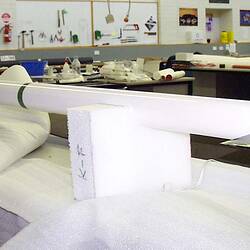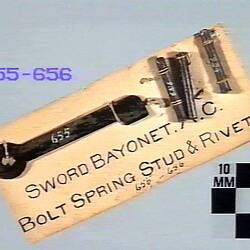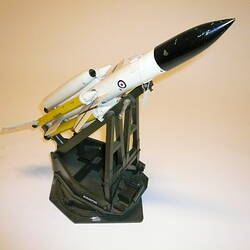Summary
Alternative Name(s): Sounding Rocket
Lorikeet Mark 2, Australian-designed, two-stage upper atmospheric research rocket powered by cast composite propellant motors (Dorado 1A & Lupus 3A). The Lorikeet Mk. 2 was built at the Maribrynong Explosives Factory and the motors static tested at nearby Ravenhall Facility in Deer Park. It was developed in the early 1970s as a replacement for the earlier Kookaburra and Cockatoo upper atmospheric research rocket designs. It was used for UV and telemetry experiments and could reach a maximum altitude (apogee) of about 130 kilometres, with a typical launch elevation of 82.5° in still air.
This example of the Lorikeet Mk. 2 is believed to have been manufactured in 1976 and remained unused at the end of the research program. It was displayed for some years outside the Maribrynong Explosives Factory head office until the facility closed in 1994 and was subsequently donated to the Museum.
Physical Description
Overall rocket consists of two slender pencil or needle-like stages with straight-sided cylindrical bodies 173 mm diameter in the lower or first stage and 126 mm diameter in the upper or second stage. Each stage has four stabilising fins attached to the nozzle at the base in a cruciform arrangement. The lower stage fins have a 45° triangular leading edge and square trailing edge, while the upper stage fins are of plain rectangular form. The body of each stage is painted cream/white, with black stenciled lettering, black fins and nozzle and a 7.5° tapered polished metal alloy nose. The lower stage is also fitted with a tapered polished metal tip which fits inside the conical nozzle of the upper stage.
More Information
-
Collecting Areas
Arms, Engineering, Information & Communication, Science & Measurement, Transport
-
Acquisition Information
Donation from Australia: Defence Department, Maribyrnong Explosives Factory, by Oct 1994
-
Manufacturer
Australia: Defence Department, Maribyrnong Explosives Factory, Maribyrnong, Greater Melbourne, Victoria, Australia, Apr 1976
Manufactrured at the Maribyrnong Explosives Factory, Victoria. Rocket motors static tested at their Ravenhall facility in Deer Park, range tested at the Weapons Research Establishment's Woomera Firing Range, South Australia. -
Designer
Upper Atmosphere Research Group, Weapons Research Establishment (WRE), Upper Atmosphere Research Group, South Australia, Australia, circa 1974
-
Place & Date Tested
Australia: Defence Department, Ravenhall Explosives Testing Range, Ravenhall, Deer Park, Greater Melbourne, Victoria, Australia, circa 1974
-
Place & Date Tested
Woomera Rocket Range, Australia: Defence Department, Weapons Research Establishment (WRE), Woomera, South Australia, Australia, circa 1974
-
Model Name or Number
-
Classification
-
Category
-
Discipline
-
Type of item
-
Overall Dimensions
5580 mm (Length), 790 mm (Width), 173 mm (Outside Diameter)
Overall dimensions when the two stages are assembled into a full rocket. Individual lengths of each part overlap by 85 mm between stages 1 & 2 and by 105 mm between stage 1 & base when assembled.
-
References
Morton, Peter, 'Fire Across the Desert', pp.402-405.
[Other] Brown, D. P. & Burger, F. G. 1974. Study of a Family of Sounding Rockets Formed by the Combination of Various Existing and Hypothetical Rocket Motors., Note-1174, March 1974
-
Keywords
Atmospheric Rockets, Sounding Rockets, Telemetry, Ultraviolet Radiation


